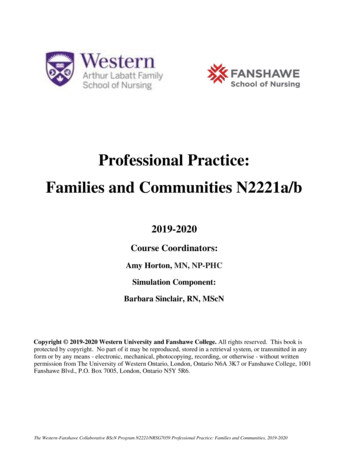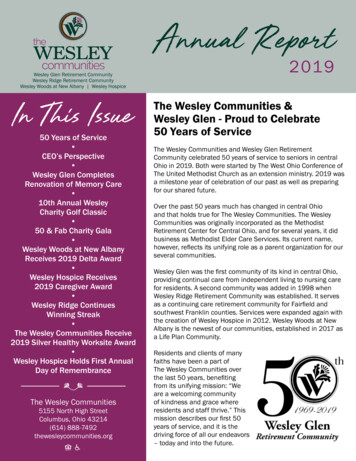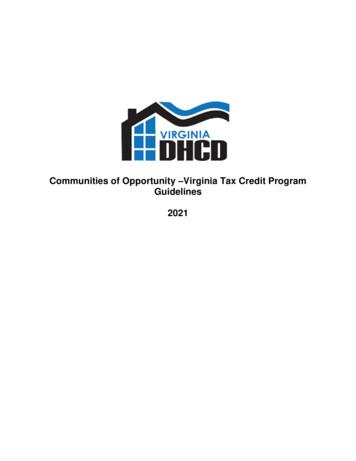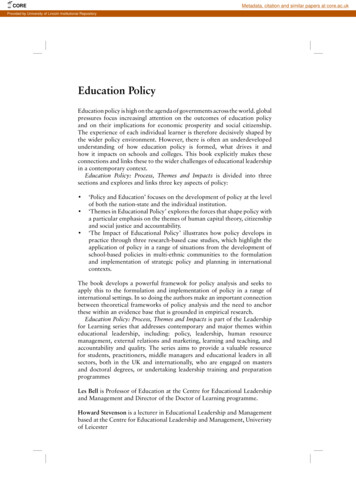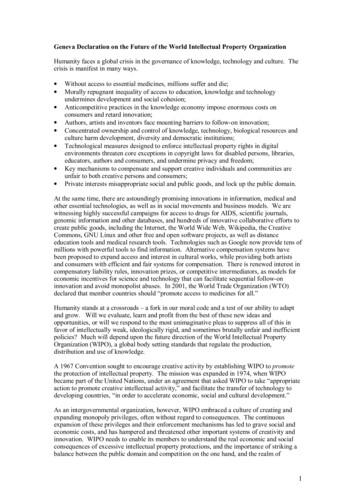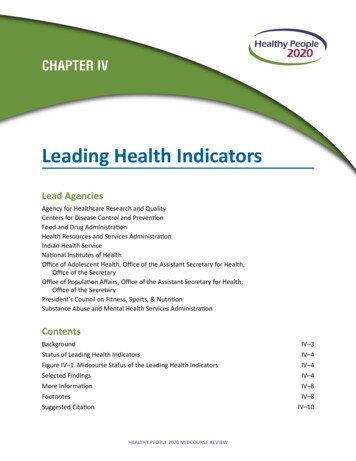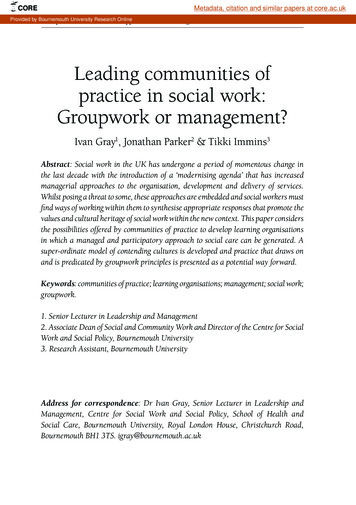
Transcription
COREMetadata, citation and similar papers at core.ac.ukProvided by BournemouthResearchGroupworkUniversityVol. 18(2),2008,pp.xxx-xx. Whiting& TikkiBirch ImminsLtd, 2008.IvanOnlineGray,JonathanParker &DOI: 10.1921/xxxxLeading communities ofpractice in social work:Groupwork or management?Ivan Gray1, Jonathan Parker2 & Tikki Immins3Abstract: Social work in the UK has undergone a period of momentous change inthe last decade with the introduction of a ‘modernising agenda’ that has increasedmanagerial approaches to the organisation, development and delivery of services.Whilst posing a threat to some, these approaches are embedded and social workers mustfind ways of working within them to synthesise appropriate responses that promote thevalues and cultural heritage of social work within the new context. This paper considersthe possibilities offered by communities of practice to develop learning organisationsin which a managed and participatory approach to social care can be generated. Asuper-ordinate model of contending cultures is developed and practice that draws onand is predicated by groupwork principles is presented as a potential way forward.Keywords: communities of practice; learning organisations; management; social work;groupwork.1. Senior Lecturer in Leadership and Management2. Associate Dean of Social and Community Work and Director of the Centre for SocialWork and Social Policy, Bournemouth University3. Research Assistant, Bournemouth UniversityAddress for correspondence: Dr Ivan Gray, Senior Lecturer in Leadership andManagement, Centre for Social Work and Social Policy, School of Health andSocial Care, Bournemouth University, Royal London House, Christchurch Road,Bournemouth BH1 3TS. igray@bournemouth.ac.uk26Groupwork Vol. 18(2), 2008, pp.xx-xx
Leading communities of practice in social work- groupwork or management?IntroductionSocial work in the UK reflects a paradox that has informed itsdevelopment throughout its short history: where social work’s aimshave been to develop autonomy, self-direction and independence thishas been juxtaposed with the social regulatory mechanisms of socialwork as a state regulated and approved profession (Dale et al., 1986;Payne, 2005). In practice, this simple binary distinction does not fullydo justice to the realities of practice and there is a much more complexrelationship between the state and the profession. However, it isinteresting to explore how concepts of regulation and control interfacewith those that are nurturing and empowering.Radical reform of the public sector has had a significant impact onsocial work (Jordan and Jordan, 2006). As noted by Parker (2007, p.763):Since 1997, and the coming to power of the New Labour government, thesocial and health care sector has been subject to significant change in the UKunder the auspices of a ‘modernising’ agenda which characterises currentsocial policy ideology and concerns striving for public service improvementthrough increased regulation, inspection and monitoring.Changes in policy and practice have led to the rationalisation ofservices, the shifting of resource across priorities, fragmentation ofsome services and the integration of others (Blewitt, 2008). This hasbeen accompanied by a rise in managerialism and bureaucracy thatintends to improve delivery through inspection and regulation (HaffordLetchfield, 2006), but may have the unintended consequence of focusingon performance issues as ends in themselves rather than on professionaljudgement and practice (Martin et al., 2004; Penhale and Parker, 2008).Social workers now operate in contexts in which multiple factorsimpact on practice. There is an increasing emphasis on working togetherwith other professionals to improve services rather than being confinedby professional roles (Barr et al., 2008; Quinney, 2006). There is anaxiological shift towards service-user led service provision (Beresford,2003). There are regulatory conditions set out in the Care StandardsAct 2000 to which social workers must subscribe alongside professionalcodes of practice (GSCC, 2002), and there are performance targets andframeworks to which employing agencies will require social workersGroupwork Vol. 18(2), 2008, pp.xx-xx27
Ivan Gray, Jonathan Parker & Tikki Imminsto contribute and service inspections to promote improvements andgrowth (Sinclair, 2008). These demands must be accommodated andform part of the lived-experience of the contemporary social worker.Negotiating through and managing such complexities requires modelsthat maintain the values of social work and promote practice consonantwith the agreed definition of social work, yet can also facilitate thedevelopment of services and social work practice and their management.By engaging more positively with a managed approach social workersmay work through the benefits of such changes whilst amelioratingsome of the problems that may arise, developing and synthesisingunderstandings that do justice to both managerial and professionalperspectives. This paper argues that, assisted by the theoreticalinsights offered by theories that address communities of practice, thedevelopment of learning organisations may provide a bridge betweenmanagerialism and professionalism and foster engagement and possiblyrapprochement. It posits that there is pressing need for research intoand theoretical development of learning organisations and communitiesof practice given the centrality of these concepts to current policy.Crucially, the paper contends that groupwork understandings and skillsare the essential building blocks of any attempt to develop learningorganisations and communities of practice and that any such endeavourdemands a melding of management and groupwork theory.Learning organisations and learning cultures insocial careThe concept of learning organisation has been given little attention insocial care (Hafford-Letchfield et al., 2008) yet it is receiving increasingattention from policy makers as an ideal to be strived for (DfES/DH, 2006). Attempts are being made to actively develop social careorganisations as learning organisations (SCIE, 2004) and to ‘enable workbased learning’ as a communal provision that can have a significantimpact on professional competence (GSCC, 2006), despite considerablepessimism as to their likely success (Gould & Baldwin, 2004).Senge’s (1990) hugely influential work identifies the features of alearning organisation as being systems thinking, personal mastery,overcoming mental models, shared vision and values, team working and28Groupwork Vol. 18(2), 2008, pp.xx-xx
Leading communities of practice in social work- groupwork or management?learning. However, it is possible to identify several different approachesto learning organisations, each striving to create different learningcultures. For instance, by introducing registration for social workerswith re-registration dependent on the demonstration of continuingprofessional development; the General Social Care Council (GSCC)can be seen to be striving for a professional learning culture. ‘Investors inPeople’ is best described as creating a managed learning culture wheretraining and learning activity is directed towards service strategy andbusiness plans. A therapeutic community can be seen as aspiring to ahumanistic leaning culture; and Total Quality Management, that seeks toaddress the negative impact of organisational hierarchy and power onworkers’ involvement in organisational problem solving, can be seen asaiming to create a democratic leaning culture (see table 1).Each culture identified in table 1 has its particular theory of learning,specific objectives, unique learning processes and defined outcomes.The figure has explanatory value in that it offers an analytical frameworkthrough which learning cultures in organisations can be explored. Forinstance, it can be argued that currently in social care a professionaland managerial learning culture dominates, whereas in the past ahumanistic and democratic learning culture may have been moreinfluential.In relation to groupwork, whereas professional and manageriallearning cultures can be individualistic and prescriptive, humanisticand democratic cultures are dependent for their development on asocial model of learning and sensitivity to the impact of the social onself and the impact of the political on learning processes. It is arguablethat such leadership and sensitivity is in turn dependent on groupworkknowledge, skills and values.Communities of practice’Communities of practice’ as an approach to learning organisations,focuses on the small group activity on which other organisationallearning processes must depend. It makes a valuable companion theoryto learning organisations but is also relatively underdeveloped (Fulleret al., 2005).Wenger (2006), defines communities of practice as:Groupwork Vol. 18(2), 2008, pp.xx-xx29
Table 1 Contending learning and development cultures and types of learning organisationIvan Gray, Jonathan Parker & Tikki Immins30Groupwork Vol. 18(2), 2008, pp.xx-xx
Leading communities of practice in social work- groupwork or management?Communities of practice are groups of people who share a concern or apassion for something they do and learn how to do it better as they interactregularly.Further he notes that they have a shared domain of interest, thatcommunity members learn and interact together, that they share a practicerepertoire of resources: experiences, stories, tools, ways of addressingrecurring problems and they ‘enable practitioners to take collectiveresponsibility for managing learning’ and they are in the best position to dothis. (Wenger, 2006). Earlier he points out that their practice provides ‘waysof ameliorating institutionally generated conflicts’. (Wenger 1998 p.46)Wenger (1998) suggests that to foster communities of practice, thereis a need to minimise prescription, set the context in which communitiescan prosper, value the work of community building and developmentand make sure participants have access to the resources they need tolearn. In stressing the social and communal nature of learning andthe dangers of prescription, he locates communities of practice inhumanistic and democratic cultures. This suggests groupwork values,understandings and skills take on a central role in developing them.In social care a ‘super-ordinate’ learning culture may be desirablethat encompasses all four cultures. Professional and managerialcultures have to be accommodated but a communal humanistic cultureis essential if the emotional nature of the work and the impact ofsociety and community on the self and learning, is to be recognised. Ademocratic learning culture is also essential if, in a similar way, socialcare is to maintain awareness and engage with the power differentialsthat disempower users and carers.Management, leadership and communities ofpracticePlaskoff (2006) notes in his exploration of community building thatcommunities of practice have grown out of a collective philosophyand that this contrasts with the atomism of many organisations. HeGroupwork Vol. 18(2), 2008, pp.xx-xx31
Ivan Gray, Jonathan Parker & Tikki Imminsexplores how management control systems can conflict with communityactivities and their development and how the distribution of powerin a hierarchical organisation can undermine trust (Plaskoff, 2006).For Plaskoff (2006, p.10) a community of practice is dependent upontrust, a sense of belonging, equality and ’thriving relationships’ andthat knowledge, cognition and intelligence are all distributed so thatlearning and practice that are indivisible are necessarily collective acts.Plaskoff (2006, p.16) further argues that leadership must also bedistributed and carefully examined in an organisation that wants todevelop communities of practice:Management must trust the wisdom of practitioners and ‘work forthose practitioners’ in creating a knowledge- enabling environment thatnurtures communities, encourages and legitimises, but does not requireparticipation, and values direction-setting at all levels.After making what seems a convincing, albeit implicit, case for theimportance of group processes and group leadership to communitiesof practice, thereafter Plaskoff’s picture of leader behaviour is perhapsrather limiting. He identifies that they have an administrative role insetting up and facilitating meetings, and distributing information butthat otherwise their role is one of ‘mentoring’. It is almost for Plaskoffthat leaders need to take a backseat when it comes to developingcommunities of practice; a similar position to Wenger in his earlierwork (Wenger, 1998).In social care, this back seat role is not congruent with a manager’s orleader’s responsibilities to develop and supervise social care practice andother writers such as Goleman have seen it as crucial that managers takeresponsibility for developing what he calls the ‘Group IQ’ which he seesas having considerable impact on organisational effectiveness (Goleman,1998). Wenger (2004) has latterly adopted a stance that allows for amore managed approach to the development of communities of practice.If instead of distributed leadership we adopt an earlier leadershipmodel, contingency or situational leadership, a leader’s role can becomemore proactive whilst maintaining the centrality of participation toa community of practice. Hersey and Blanchard’s (1993) theory ofsituational leadership offers an approach to leadership which can be seenas congruent with social care values and is supported by a conceptual32Groupwork Vol. 18(2), 2008, pp.xx-xx
Leading communities of practice in social work- groupwork or management?framework that is based on groupwork theory.It is ‘situational’ in that a leader’s behaviour needs to vary fromsituation to situation and Hersey and Blanchard focus on how it needsto vary according to the characteristics of the team, group or individualstaff member. They see teams and groups of staff as being at differentdevelopmental levels that demand different leadership styles. So if ateam or staff member is very new they may not understand the purposeof the work or be motivated to do it. They may not have the skillsand knowledge to carry out the tasks and may need instruction andsupervision if they are to be able to function appropriately.On the other hand, an experienced team or staff member may bemore self motivated and well equipped to do the work, have a strongervalue base, knowledge of essential procedures and objectives andthe skills and knowledge to practice effectively. So a team leader canallow them every opportunity to participate in the management anddevelopment of practice and can delegate to them. Developed teams willrequire a minimalist facilitation and individuals will take responsibilityfor their work, reporting back to the team leader, keeping them briefedon progress or consulting on significant problems - but otherwiseworking independently.The model is founded on the stages of group development and theprinciples of group leadership. It is very applicable to health and socialcare situations because of a number of features and these are alsoconcordant with the leadership of a community of practice at differentlevels. The approach is developmental. The leader’s behaviour helps theteam and staff member improve their performance over time so thateventually they are able to function independently. It is participative,as development can only be achieved by engaging the team and staffmember in the purpose of the organisation and the management ofthe task.Hersey and Blanchard’s theory raises several crucial questionsthat are the basis of community leadership. Is my leadership varying torespond to the needs of the community? Is there evidence of the communityworking more independently over time and developing their practice, allowingme to shift style to facilitation and delegation? Can I see evidence of thecommunity taking an increasing role in enabling and developing colleagues?Can I see evidence of the community taking an increasing role in reaching toinvolve others who reside in the network of service provision and the widerGroupwork Vol. 18(2), 2008, pp.xx-xx33
Ivan Gray, Jonathan Parker & Tikki Imminsorganisation?The situational leadership model would seem to be directly compatiblewith the needs of a community of practice and would make leadershipcentral to their effective development. As an approach groupwork is at itsheart and it is located in humanitarian and democratic learning cultures.In fact, it could be seen as key to the development of such cultures.Learning organisations and communities ofpracticeCommunities of practice can therefore be seen to offer an alternativeperspective and approach to developing a learning organisation. It couldbe characterised as a ‘bottom up’ approach in contrast to a ‘top down’learning organisation approach. It places team and group activity atthe heart of service and practice development and it relies on team orgroup leadership to be effective.Potentially, it is a super-ordinate model that does justice to all fourlearning cultures (see table 1), integrating them into a co-ordinatedwhole where individual, managerial and communal needs are metand all of a teams resources directed towards developing services andpractice.In developing the concept of communities of practice Wenger (1998)could be seen to set small group processes against organisationalprocesses as a way of meeting the needs that the organisation, throughits institutionalised initiatives, does not. That is, they socialise theworkplace making it fit for group life and develop pragmatic solutionsto problems, whatever the organisational practices.In the eyes of a host organisation this could be seen as subversive.For instance, Wenger gives examples of situations where work groupsmodify prescribed procedures to make them work. For the workgroup itis simply expedient, a way of maintaining the activity of the group andits effectiveness in the face of ineffective prescription. To the organisationit could be more threatening. So in a ‘communities of practice’ approachsmall group activity may or may not be accommodated by the widerorganisation, depending on whether or not it aspires to become alearning organisation of a type that recognises the importance ofcommunities of practice.34Groupwork Vol. 18(2), 2008, pp.xx-xx
Leading communities of practice in social work- groupwork or management?The strength of a communities of practice approach is that a team orgroup leader can still adopt it to good effect even in an unsupportiveorganisation. Even in an organisation dominated by managerialism itis possible to create a ‘window’ of good communal practice. A leaderwill, however, need to give careful attention to managing the interfacewith the wider organisation to ensure that its demands and imperativesdo not undermine the community of practice and to ensure that theorganisation does not come to see the community of practice as a threat.For instance, therapeutic communities as communities of practicecan be seen to have been particularly prone to this conflict with thehost organisation and therefore prone to closure (Hinshelwood andManning, 1979). The high failure rate of early Total Quality Managementinitiatives could also be seen as resulting from the conflicts created byempowering work teams in a hierarchical organisation ( Klein, 1981;Thompson, 1982)In exploring knowledge management in private sector organisationsthrough communities of practice, Nonaka and Konno (1998) developthe concept of ‘ba’ which they define as a ‘shared place for knowledgecreation’. They suggest that it is a place where relationships developand that ‘knowledge is embedded in ba (in these shared spaces),where it is then acquired through one’s own experiences or reflectionson the experiences of others’ (Nonaka and Konno, 1998, pp.40-41).These shared spaces enable team leaders and community membersto improve and develop practice, creating evidence for future practicedevelopments. Essentially they are group experiences that demandgroup interventions to facilitate learning.Leading communities of practice- essentialunderstandings and skillsThe learning cultures model (see Table 1) provides a bridge betweenlearning organisations and communities of practice by clarifying thedifferent cultures that must be accommodated and the different groupprocesses that must be enabled to achieve a super-ordinate model. Thisgenerates both organisational and community understandings andallows agendas to be set for organisational and community leadership.At both levels the understandings are of group processes and theGroupwork Vol. 18(2), 2008, pp.xx-xx35
Ivan Gray, Jonathan Parker & Tikki Imminsinterventions are groupwork interventions. In the super-ordinate modelall the cultures in order to be integrated must be shaped by groupworkvalues, skills and understandings and this common foundation alsorecognises and allows the tension between communities of practice andthe wider organisation to be resolved or brokered.So, if there is a need to expand research into both learningorganisations and communities of practice in social care, from ourlimited discussion it is possible to identify some of the parameters ofsuch an endeavour and the component parts of what is an extensiverepertoire of values understanding and skills that the leaders of superordinate learning organisations or communities of practice will need.Groupwork theory and skills dominate this repertoire as illustratedbelow in figure 1:The future of communities of practice in social careIn order to provide the maximum momentum to the development oflearning organisations and communities of practice in social care, thereis a compelling argument for this rather demanding learning agendato be provided to all the stakeholders of a learning organisation or acommunity of practice.This would mean, for instance, explicit integration of groupwork intosocial work degree programmes and the Post Qualifying leadership andmanagement pathway (GSCC, 2005). It would need to begin to appear aspart of in–house training and would have to be at the centre of the newspecialist level Post Qualifying unit ‘Enabling Work Based Learning’(GSCC, 2006). Yet the evidence is that the provision of trainingopportunities for managers that address learning and development iscurrently rudimentary (Brown et al, 2007), and social work qualifyingprogrammes already have an overcrowded curriculum.Furthermore, whilst learning organisations are on the managerialagenda, there is little understanding of the super-ordinate modelof learning culture or communities of practice and current policyinitiatives do not reach for it or for humanitarian and democraticcultures. As Wenger suggests (1998, p.10) organisations are designsand designs create their own discourse that justifies them. Social carecould be seen as locked into professional and managerial cultures,36Groupwork Vol. 18(2), 2008, pp.xx-xx
Leading communities of practice in social work- groupwork or management?Fig. 1. Groupwork and the skills for developing communities of practicedesign initiatives and discourse.So, to be pessimistic, whilst social care may well exhibit and achievethe features of professional and managed learning cultures, the moredemanding but more effective features of humanistic and democraticmodels may elude it and the promise of the super-ordinate model maynot be achieved. Rather, line managers with groupwork backgrounds,that allow them to lead the learning and development of their teamsmore effectively than others, will negotiate and broker top downprescription and create windows of attainment where, despite the odds,the super-ordinate model will find some expression.More positively there is perhaps compatibility between the valuesof social care and the communities of practice approach and, whenspace is created for humanistic and democratic learning culture,the development of learning organisations. There is a population ofGroupwork Vol. 18(2), 2008, pp.xx-xx37
Ivan Gray, Jonathan Parker & Tikki Imminsmanagers and professionals with existing groupwork understandingsand skills that will allow them to quickly relate to learning organisationand communities of practice theory and quickly develop them and carrythem into practice.Community of practice initiatives in social care would mirror theknowledge management initiatives being taken in the most competitiveof private sector organisations with, it could be argued, the greaterpossibility of success. For social care practitioners are motivated by astrong value base that means they seek to empower others and shouldhave a developed self awareness and awareness of others from theirtraining in social work methods and their everyday practice. In effectthey come to the table with the motivation perspectives and skills thatwould support the development of communities of practice. Developingcommunities of practice could therefore be a crucial opportunity toreach for. An opportunity that may prove truly productive in enhancingservice quality and improving performance, but that will use groupworkskills and perspectives to build a bridge between managerialism andprofessional values, practices and experiences.ReferencesBarr, H., Goosey, D. and Webb, M. (2008) Social work in collaboration withother professions. in M. Davies (Ed.) The Blackwell Companion to Social Work.(3rd ed.). Oxford: Blackwell (pp.277-286)Beresford, P. (2003) It’s Our Lives: A Short Theory of Knowledge, Distance andExperience. London: Citizen PressBlewitt, J. (2008) Social work in new policy contexts: Threats and opportunities.in S. Fraser and S. Matthews (Eds.) The Critical Practitioner in Social Work andHealth Care. London: SageBrown, K., Immins, T., Bates, N., Gray, I., Rutter, L., Keen, S., Parker, J., andmembers of the Project’s Steering Group (2007) Tracking the Learning andDevelopment Needs of Newly Qualified Social Workers Project. Leeds: Skills forCareCare Standards Act (2000). Care Standards Act 2000. London: HMSODale, P., Davies, M., Morrison, T., and Waters, J. (1986) Dangerous Families.London: TavistockDfES/DH (Department of Health) (2006) Options for Excellence. Building the social38Groupwork Vol. 18(2), 2008, pp.xx-xx
Leading communities of practice in social work- groupwork or management?care workforce of the future. London: DfES/DHFuller, A., Hodkinson, H., Hodkinson, P., and Unwin, L. (2005) Learning as aperipheral participation in communities of practice: a reassessment of keyconcepts in workplace learning. British Educational Research Journal, 31, 1,49-68GSCC (2002) Codes of Practice for Social Care Workers and Employers. London:General Social Care CouncilGSCC (2005) Specialist Standards and Requirements for Post Qualifying Social WorkEducation and Training. Leadership and management. London: General SocialCare CouncilGSCC (2006) Specialist Standards and Requirements for Post-Qualifying SocialWork Education and Training. Practice education. London: General Social CareCouncilGoleman, D. (1998) Working with Emotional Intelligence. London: BloomsburyGould, N. and Baldwin, M. (2004) Social Work, Critical Reflection and the LearningOrganisation. Aldershot: AshgateHafford-Letchfield, T. (2006) Management and Organisations in Social Work.Exeter: Learning MattersHafford-Letchfield, T., Leonard, K., Begum, N., Chick, N.F. (2008). Leadershipand Management in Social Care. London: SageHersey, P. and Blanchard, K.H. (1993) Management of Organisational Behaviour:Utilising human resources. (6th ed.). London: Prentice HallHinshelwood, R.D. and Manning, N. (1979) Therapeutic Communities: Reflectionsand progress. Abingdon: RoutledgeJordan, B. and Jordan, C. (2006) Social Work and the Third Way: Tough love associal policy. (3rd ed.). London: SageKlein, G. (1981) Implementing quality circles: A hard look at some of therealities. Personnel Review, November/December 1981Martin, G.P., Phelps, K., and Katbamna, S. (2004) Human motivation andprofessional practice: Knights, knaves and social workers, Social Policy andAdministration, 38, 5, 470-87Nonaka, I. and Konno, N. (1998) The Concept of ‘Ba’: building a foundation forknowledge creation. California Management Review, 40, 30, 40-54Parker, J. (2007) Developing effective practice learning for tomorrow’s socialworkers, Social Work Education, 26, 8, 763-79Payne, M. (2005) The Origins of Social Work: Continuity or change. Basingstoke:PalgravePenhale, B. and Parker, J. (2008) Working with Vulnerable Adults. London:Groupwork Vol. 18(2), 2008, pp.xx-xx39
Ivan Gray, Jonathan Parker & Tikki ImminsRoutledgePlaskoff, J. (2006) Intersubjectivity and Community Building: Learning to learnorganizationally. in M. Easterby-Smith and M.A. Lyles (Eds.) Handbookof Organizational Learning and Knowledge Management. Retrievedon 7th April 2008 from Blackwell Reference Online site at www.blackwellreference.com/subscriber/uid 44/tocnode?id g9780631226727chunk g978063122672713Quinney, A. (2006) Collaborative Social Work Practice. Exeter: Learning MattersSCIE (2004) Learning Organisation: A self assessment resource pack. London: SocialCare Institute for ExcellenceSenge, P.M. (1990). The Fifth Discipline. The art and practice of the learningorganisation. London: Random HouseSinclair, I. (2008) Inspection: A quality-control perspective. in M. Davies(Ed.) The Blackwell Companion to Social Work. (3rd ed.) Oxford: Blackwell(pp.449-57)Thompson, W. (1982) Is the organisation ready for quality circles. Training andDevelopment Journal, DecemberWenger, E. (1998). Communities of Practice. Learning, Meaning and identity.Cambridge: Cambridge University PressWenger, E. (2004) Knowledge management as a doughnut: Shaping yourknowledge strategy through communities of practice. Ivey Business Journal,68, 3, 1-8Wenger, E. C. (2006) Communities of Practice: A brief introduction. Retrieved 15thOctober 2007 from http://www.ewenger.com
form part of the lived-experience of the contemporary social worker. Negotiating through and managing such complexities requires models that maintain the values of social work and promote practice consonant with the agreed definition of social work, yet can also facilitate the development of services and social work practice and their management.

